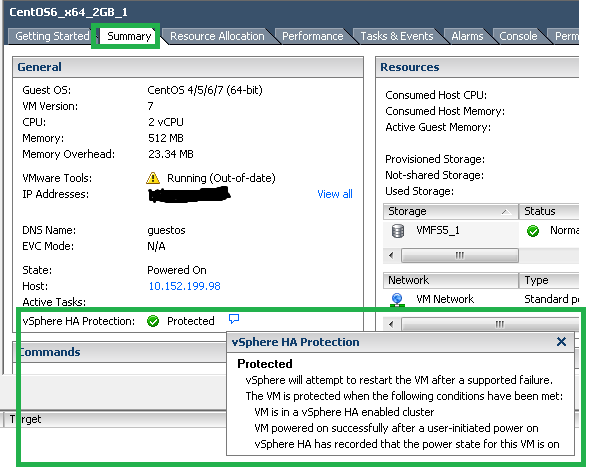Sometime back I got a question on VMTN & also one of friends had same doubt. Hence I thought it is worth to have one small post on this. Question was: Even when VM restart priority and VM monitoring settings are disabled for a particular VM in HA enabled cluster, why vCenter Server reports that VM as HA protected?
First of all, I would suggest you to look into below screenshot taken from VI client VM summary tab.

According to the VM summary, below condition should meet in order vCenter to report VM as HA protected.
– VM is in a vSphere HA enabled Cluster.
– VM powered on successfully after a user-initiated power on.
– vSphere HA has recorded the power state for this VM is on.
Note that vSphere HA maintains one file called “Protectedlist” for all the VMs in HA enabled cluster in order to identify which VMs are protected. Below is sequence of steps takes place when we power on the VM in HA cluster.
1. When we power on VM from vCenter, vCenter informs ESXi host to power on the VM.
2. When VM is powered on, host informs vCenter that VM is powered ON.
3. vCenter then contacts vSphere HA master for making powered ON VM protected.
4. HA master makes entry into “ProtectedList” file which exhibits that Master is now responsible to restart the VM when there is failure.
5. Finally HA master informs vCenter that I have added the entry into “ProtectedList” file & then vCenter reports VM as HA protected in VI client as we see in above screenshot.
Original question “When VM restart priority & VM Monitoring are disabled, why does vCenter report as HA protected?” is still unanswered. Here is the answer:
Note that By design, “VM restart priority” and “VM monitoring” settings are orthogonal to vSphere HA protection. vSphere HA protection state has nothing to with restart priority and VM monitoring settings, no matter these settings are enabled or disabled. Now one more question arises i.e. is it possible that HA removes VM from protectedList when we disable either or both settings (i.e. VM restart priority & VM monitoring)? Diplomatic answer is :It depends. We will see sequence of actions that HA takes on VM protected state when we disable either or both of these settings in case of failure.
1. if VM restart priority is disabled & VM monitoring is enabled:
-Host is up and VM is up, vSphere HA will keep VM in protected list.
-When ESXi host fails, VM can not be restarted on other available host. Even If failed host comes back, still VM will not be restarted, it will be powered OFF and now vSphere HA will remove that VM from protected list.
-When Guest OS fails (ex. BSOD), HA will reset that Guest on the same host and HA continue to keep in protected list. It shows that VM monitoring is orthogonal to restart priority as well.
2. if VM restart priority is disabled & VM monitoring is also disabled:
-Host is up and VM is up, vSphere HA will keep in protected list.
-When ESXi host fails, VM can not be restarted on other available host. Even If failed host comes back, still VM will not be restarted, it will be powered OFF and now vSphere HA will remove that VM from protected list.
-When Guest OS fails, HA can not restart that Guest OS on the same host but as VM itself does not have any issue (i.e. VM is ON but you can not access Guest), HA continue to keep that VM in protected list.
3.if VM restart prioriy is enabled & VM monitoring is disabled:
-Host is up and VM is up, vSphere HA will keep in protected list.
-When ESXi host fails, VM will be restarted on other available host, After restart, VM will be powered ON and HA continue to keep that VM in protected list
-When Guest OS fails, HA can not restart that Guest on the same host but as VM itself does not have any issue (VM is ON but you can not access Guest), HA continue to keep that VM in protected list.
There are 3 state of the VM from HA perspective, today’s post was focused on Protected VM state, there are 2 more i.e. unprotected and N/A, I will write another post later on additional two VM HA state.
Learn more on vSphere HA here
I hope you enjoyed this post. Please let me know if you have any additional doubts.

Vikas Shitole is a Staff engineer 2 at VMware (by Broadcom) India R&D. He currently contributes to core VMware products such as vSphere, VMware Private AI foundation and partly VCF . He is an AI and Kubernetes enthusiast. He is passionate about helping VMware customers & enjoys exploring automation opportunities around core VMware technologies. He has been a vExpert since last 11 years (2014-24) in row for his significant contributions to the VMware communities. He is author of 2 VMware flings & holds multiple technology certifications. He is one of the lead contributors to VMware API Sample Exchange with more than 35000+ downloads for his API scripts. He has been speaker at International conferences such as VMworld Europe, USA, Singapore & was designated VMworld 2018 blogger as well. He was the lead technical reviewer of the two books “vSphere design” and “VMware virtual SAN essentials” by packt publishing.
In addition, he is passionate cricketer, enjoys bicycle riding, learning about fitness/nutrition and one day aspire to be an Ironman 70.3
Thanks a lot for your encouragement